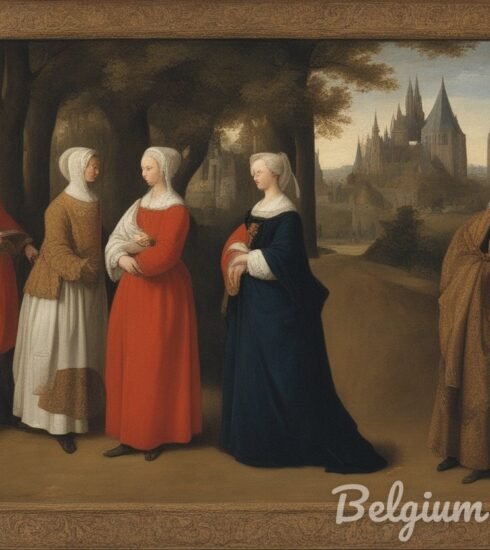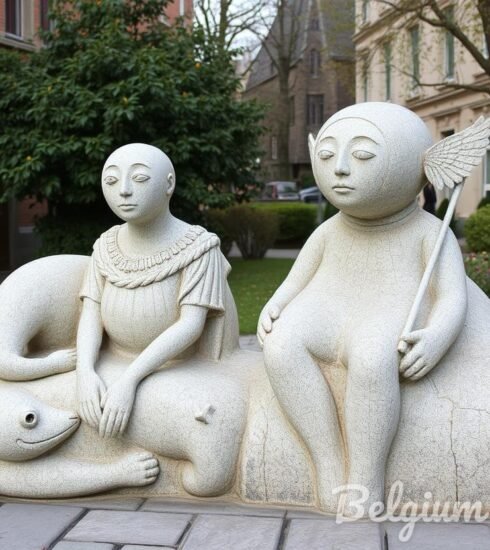Unveiling the Enchanting Realm of Belgian Art: Dive into this Captivating Article on Surreal Delights
Introduction
Belgium: a land known for its rich history, culinary delights, and of course, its incredible art. In the realm of art, Belgium has given birth to many renowned artists who have left an indelible mark on the world. One particular genre that has captivated art enthusiasts for decades is surrealism. Surreal Belgian art is a unique and captivating form of artistic expression that transports viewers to a world that is simultaneously enchanting and bewildering. In this article, we will take a delightful dive into the surreal world of Belgian art, exploring its origins, key artists, and iconic masterpieces that continue to inspire and captivate audiences to this day.
Origins of Surrealism in Belgium
The surreal art movement emerged in Belgium in the early 20th century, during a time of great political and societal change. Influenced by the works of Andre Breton and other surrealist artists in France, Belgian artists began to experiment with new ways of expressing their innermost thoughts and exploring the subconscious mind. The surrealists sought to break free from the constraints of logic and reason, creating dreamlike and fantastical worlds that challenged conventional notions of reality.
One of the key figures in the Belgian surrealism movement was René Magritte. Born in 1898 in Lessines, Magritte is often hailed as one of the greatest surrealists of all time. His distinctive style, characterized by precise and detailed renderings of everyday objects juxtaposed in unexpected and surreal contexts, has made him an iconic figure in the art world. Magritte’s work often explores themes of perception, identity, and the nature of reality, inviting viewers into a world where ordinary objects take on new and unexpected meanings.
An article available at https://belgium-trip.fun/art-and-culture/opulent-surrealism/.
Another notable figure in Belgian surrealism is Paul Delvaux. Born in 1897 in Antheit, Delvaux’s work is characterized by hauntingly beautiful, yet somewhat eerie, landscapes populated by enigmatic women. His paintings often feature deserted cityscapes, moonlit train stations, and mysterious, often nude, female figures. Delvaux’s unique blend of classical mythology, dreamlike imagery, and meticulous attention to detail have made him a celebrated figure in the surrealist art movement.
Key Artists of Surreal Belgian Art
While Magritte and Delvaux are certainly two of the most well-known surrealists from Belgium, there are many other talented artists who have contributed to the rich tapestry of surreal Belgian art. Let’s explore some of these influential figures:
- Marcel Broodthaers: Broodthaers was a multidisciplinary artist who worked in a variety of mediums, including painting, sculpture, film, and poetry. His work often challenged traditional notions of art and sought to explore the role of language and symbolism.
- James Ensor: Ensor’s work, though not strictly categorized as surrealism, often displays elements of the fantastical and the absurd. His paintings are filled with grotesque figures, masks, and theatrical imagery, reflecting a fascination with the macabre and the carnivalesque.
- Marcel Mariën: Mariën was not only a surrealist artist but also a writer and photographer. His work often delved into the realms of the subconscious and explored themes of desire, eroticism, and the repressive nature of society.
- Luc Tuymans: While Tuymans is known for his figurative paintings, his works often possess a dreamlike quality that blurs the lines between reality and imagination. His subdued color palette and haunting subject matter evoke a sense of unease and mystery.
These artists, along with many others, have played a significant role in shaping the surrealist landscape of Belgian art. Their unique visions and contributions continue to inspire artists and art enthusiasts around the world.
Iconic Masterpieces of Surreal Belgian Art
Within the realm of surreal Belgian art, there are several masterpieces that have achieved global acclaim. Let’s delve into some of these iconic works:

“The Son of Man” by René Magritte
Perhaps one of the most recognizable paintings in the world, “The Son of Man” by René Magritte is an enigmatic and thought-provoking piece. The painting depicts a suited man with an apple obscuring his face, leaving the viewer to wonder about the man’s identity and the symbolism behind the apple. This painting is a testament to Magritte’s ability to create visually striking images that invite contemplation and reflection.
Internal link to https://belgium-trip.fun/art-and-culture/error-failed-to-retrieve-the-keyword-13/.
“The Persistence of Memory” by Salvador Dalí
Although Salvador Dalí was not Belgian, his iconic painting “The Persistence of Memory” cannot be overlooked when discussing surreal art. This masterpiece features melting clocks draped over surreal landscapes, highlighting Dalí’s fascination with the fluidity of time and the collapse of traditional notions of reality. The painting has become one of the most famous and enduring images of surrealism.
“The Red Tower” by Paul Delvaux
In “The Red Tower,” Paul Delvaux showcases his unique ability to create haunting and otherworldly landscapes. This painting features a deserted cityscape, with a striking red tower dominating the scene. Nude women wander through the desolate streets, creating a sense of mystery and unease. Delvaux’s meticulous attention to detail and his ability to evoke emotion through his paintings are on full display in “The Red Tower.”
The Legacy of Surreal Belgian Art
The impact of surreal Belgian art extends far beyond the borders of Belgium. It has inspired and influenced countless artists, photographers, filmmakers, and writers around the world. The surrealist movement, with its emphasis on the exploration of the subconscious and the rejection of conventional reality, paved the way for future artistic experimentation and continues to shape contemporary art.
Belgium, with its rich art history, has embraced the legacy of surrealism in various ways. The country is home to numerous galleries and museums that showcase the works of Belgian surrealist artists. The Magritte Museum, located in Brussels, is dedicated to the life and work of René Magritte. It houses the largest collection of Magritte’s paintings, drawings, and sculptures, offering visitors a comprehensive look into the artist’s unique vision.
In addition to museums, Belgium also hosts surrealism-themed events and exhibitions that celebrate the country’s rich artistic heritage. These events attract art enthusiasts from around the world, providing them with the opportunity to immerse themselves in the captivating world of surreal Belgian art.
An article available at https://belgium-trip.fun/art-and-culture/opulent-surrealism/.
Furthermore, surreal Belgian art continues to inspire contemporary artists who draw upon the motifs and techniques established by the surrealist movement. Artists such as Wim Delvoye and Hans Vandekerckhove have incorporated surreal elements into their work, creating pieces that resonate with audiences and push the boundaries of artistic expression.
Conclusion
Surreal Belgian art is a captivating and enchanting form of artistic expression that has left an indelible mark on the art world. With its origins rooted in the early 20th century, Belgian surrealism continues to inspire and captivate audiences to this day. René Magritte, Paul Delvaux, and other influential artists have created iconic masterpieces that challenge notions of reality and invite viewers into a world of wonder and imagination. The legacy of surreal Belgian art lives on through exhibitions, museums, and the work of contemporary artists who draw upon its rich heritage. As we continue to explore the realm of surreal Belgian art, we are reminded of the limitless possibilities of artistic expression and the power of the imagination.






